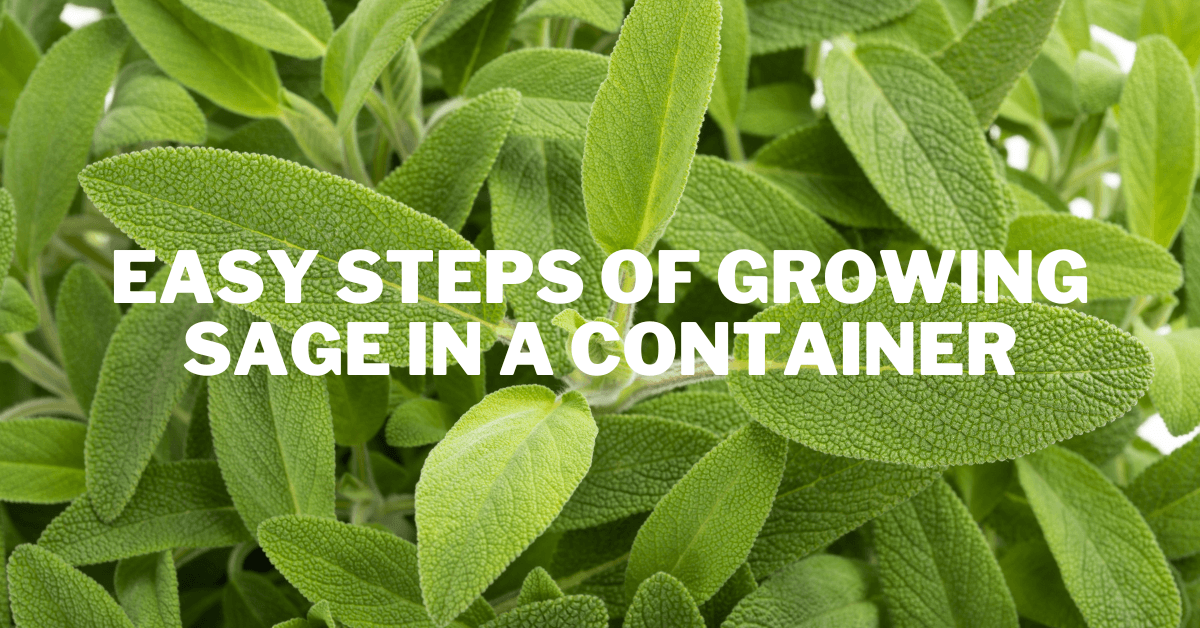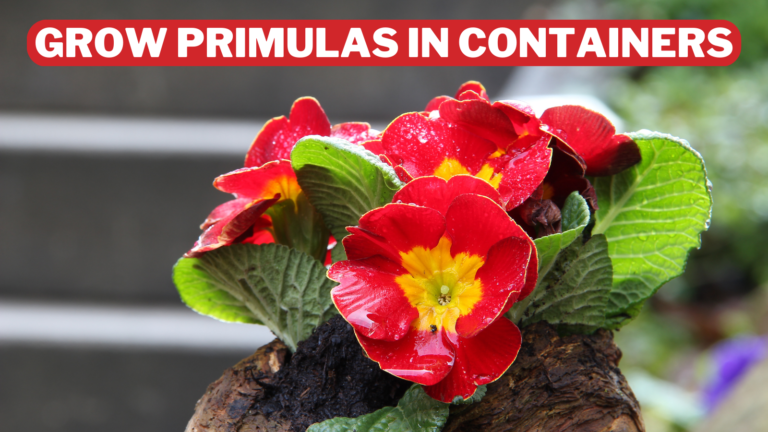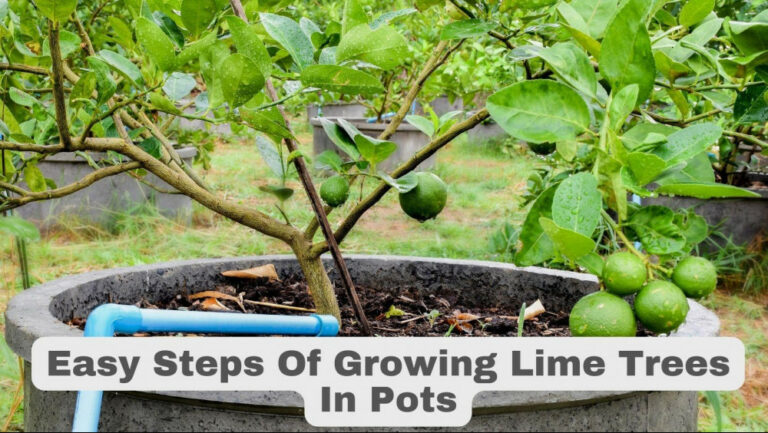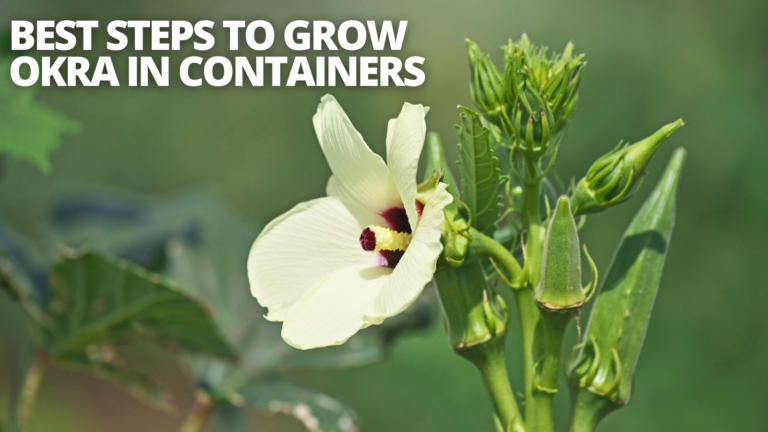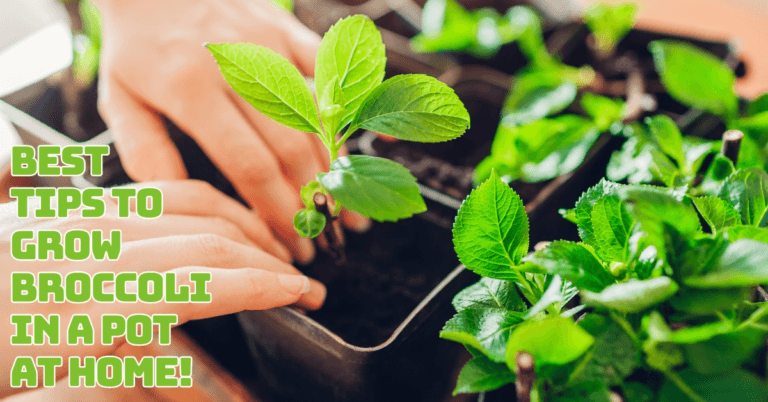Easy Steps Of Growing Sage In A Container
Easy Steps Of Growing Sage In A Container
Sage is a popular perennial kitchen herb that is used in a variety of mouthwatering dishes. It grows well in pots in small spaces, both outdoors and indoors.
It only requires the right soil, sunlight, environment, and care. This article will teach you everything you need to know about growing sage in a container perfectly.
Origin Of Sage
Sage (Salvia officinalis) is a Mediterranean plant spread over Europe and North America. This spicy herb is a member of the Lamiaceae, or mint, family and is known as garden sage, meadow sage, and true sage. The name of the genus comes from the Latin salvare, which means “to save.”
Sage was listed in official lists of medical herbs, as shown by the specific designation officinalis.
Sage comes in various species, including clary sage (S. sclarea), which got its name from its historical usage as an eyewash.
Native Americans used the roots and leaves of lyre-leafed sage (S. lyrata L.), also known as cancerweed, to treat sores and as a tea to treat colds and coughs.
Salvia officinalis, generally known as standard or garden sage, is a fragrant mint family (Lamiaceae) herb grown for its aromatic, edible leaves.
Sage is a Mediterranean herb that can be used fresh or dried to flavour various meals, including poultry, pork stuffing, and sausages.
Several kinds are planted as ornamentals because of their lovely leaves and blossoms. Sage is also a common name for several other Salvia species. The ancient Greeks used sage to heal snake bites.
The herb enthralled the Romans so much that they cut it with great flourish in a ritual that required the people cutting it to wear specific clothes.
Their feet were ceremoniously cleansed, and they sliced the herb with a special knife that wasn't made of iron because iron affected the chemical composition of sage when it came into contact with it.
Sage has been utilized for medical purposes throughout history. It aids in regulating fever by encouraging sweat, which cools the body.
Sage tea relieves indigestion and is also proven to help people with diabetes control their blood sugar levels.
Types Of Sage
Sage is an excellent choice if you're seeking an easy-to-grow herb. It is attractive and functional in the kitchen because of its compact form, resistance to pests and diseases, and ability to withstand less-than-perfect care. Many gardeners like planting this attractive perennial herb in their home gardens.
Sage comes in various types and can be classified in numerous ways. Some gardeners cultivate sage just for the leaves, while others grow it for its decorative aspects and as a fantastic companion plant. You should find the best variety of sage for growing sage in a container.
1. Garden Sage (Salvia officinalis)
If you've seen sage in a garden or the wild, you've probably seen garden sage. The Salvia officinalis, sometimes known as common sage or culinary sage, is the most popular variety.
Its lovely appearance is due to bright green leaves and stems and purple to pink flowers (sometimes slightly blueish).
Many “common sage” alternatives are available, with sizes, colours, leaf shapes, and even uses (some don't even produce flowers) varying wildly.
On the other hand, the common one can reach a height of approximately 3 feet, grows in a bushy pattern, thrives in full sun (but tolerates some shade), and produces one of the most appealing scents.
The garden sage is the easiest to find, grow, and care for and is ready to thrive in your gardens and become a go-to alternative for teas and dressings.
2. Anise-Scented Sage (Salvia guaranitica)
Another popular kind is anise-scented sage. It is one of the simplest to notice in gardens, with purple-blue blossoms and deep-green leaves. Unlike regular sage, this one is entirely ornamental.
Not only because of its unusual flowers and foliage but also because it may reach over 6 feet. In frigid climates, it grows as a perennial.
It can also be grown as an annual in warm areas. Like other sages, it favours damp soils, but it can withstand dryness for a few months. Its aroma is anise-like, woody and spicy, which is where the name comes from.
3. Autumn Sage (Salvia greggii)
Autumn sage is a cold-climate sage that thrives all year, even in the coldest climates. However, it thrives in warm climates because it is drought-tolerant and can endure high temperatures.
In well-draining soils with sufficient humidity, the plant can reach 3 feet. It also produces pink to purple flowers that are occasionally orange or crimson.
It's more common in gardens than in the wild, as it's more of an appealing ornamental than a culinary. It's also worth having in the kitchen because of its minty fragrance and flavour.
4. Blackcurrant Sage (Salvia microphylla)
Blackcurrant sage is a high-elevation sage that prefers frigid climates. It is also known as Graham's or Myrtle of the Mountains. This sage is used in sweets and is more of a culinary sage than a decorative sage.
But that doesn't take away from its beauty; its purple flowers stand out in any garden. Under the appropriate conditions, it can reach heights of over 3 feet. It grows best in well-draining soils with some humidity.
5. Clary Sage (Salvia sclarea)
Clary sage is an African and Asian species more commonly used in the kitchen than in the garden. It's also found in many perfumes. This species can only survive in high-humidity environments and demands moist soil.
The plant requires frequent hydration and freezing weather to grow tall (up to 4 feet). It looks formidable When fully grown, with flowers ranging from purple to pink to pale crimson, making any garden stand out.
6. Cleveland Sage (Salvia clevelandii)
Cleveland sage is also known as the Jim sage or Blue sage. Native to California, this popular variety is expected to thrive in warm climates with high relative humidity. It also favours sandy, well-draining soils.
Its height, which can exceed 5 feet in the appropriate conditions, sets it apart. However, its appeal is not so much its height as its attractiveness. With its ash-green foliage and blue-to-pink blossoms, it's difficult to miss.
The blossoms differ from other types of sage in that they are generally spiralled rather than spiked. As a result, it is more commonly employed as a decorative than a culinary variety.
7. Grape-Scented Sage (Salvia melissodora)
As the name suggests, this sage has a little grapey aroma that is simple to detect. As a result, it is often used as a tea and in culinary preparations.
The grape-scented sage leaves are generally light green, while the blossoms have a purple-grape tint. In the correct setting, it could also serve as an ornament.
It prefers humid environments to drier ones. It reaches a height of around 4 feet and has some of the thickest stems available. It stands out because of its bushy look and ability to spread swiftly.
8. Greek Sage (Salvia fruticosa)
If you don't like purple, red, pink, or blue, sage white is a good option. The Greek sage proposes this. It is also sold in stores as Faskomilo tea, one of the most popular culinary variants.
Like the fragrance, the minty flavour makes it a popular tea variety. This creature prefers warm environments to chilly ones. However, it does better in humid environments than in dry ones.
9. Hummingbird Sage (Salvia spathacea)
Hummingbird sage, also known as pitcher sage, has dark green foliage and dark purple blooms, making it one of the darkest.
Each flower grows like a spike, reaching over 4 feet in the right conditions. It's also one of the easiest to cultivate, as it tolerates a bit of drought and shade.
This one, too, spreads quickly. It's also disease and pest-resistant because it doesn't get sick in difficult situations. Given its unusual leaf and bloom colour, it's better suited as a decorative than a culinary sage.
10. Mexican Bush Sage (Salvia leucantha)
Mexican bush sage is one of the oldest types, growing bushy as its name suggests. Its ultra-long spikey flowers, commonly pink and purple, can reach lengthy lengths, giving it a bushy appearance.
Most Mexican bush sage plants reach around 3 feet and enjoy humid to dry settings. It also grows well in direct sunlight.
It is utilized as an ornamental because of its solid pink colour and unique bloom shape. Its fast-spreading capacity allows it to cover enormous regions in a short amount of time.
11. Pineapple Sage (Salvia elegans)
This is the other most popular sage after common, with deep-red blossoms that occasionally bloom purple.
Most of its leaves are tiny, and the flower spikes are slender. It gets its name from the citrus flavour and scent. This sage resembles a pineapple and is also one of the most popular in the kitchen. People utilize teas and sweets for everything. The plant can reach about 5 feet and thrives in various conditions.
However, it likes cold and humid conditions. Salvia Elegans comes in various variations, some more aromatic and deeper red than ordinary sage.
12. Sonoma Sage (Salvia sonomensis)
Salvia sonomensis is the tiniest of all the sages, growing no more than a foot tall and producing pale purple-to-blue blooms.
Some of the rarest types have white blooms. This is another common sage species in California, and it thrives in both warm and cold climates.
Most Sonoma sage types are utilized for ornamental purposes due to their moderate flavour and scent.
13. White Sage (Salvia apiana)
Salvia apiana, or white sage, is the only sage explicitly grown for human use. It has a pine-like perfume that sticks out in any garden, so there's no dispute about its peppery flavour. Because of the rarity of its white blossoms, it's nevertheless a decent ornamental.
This one produces circular flowers rather than spikey ones, like bunches. It prefers moist, well-draining soil, plenty of sunlight, and cold over warmth when it comes to growth.
Growing Sage In A Container
Sage is a common perennial kitchen herb in mouthwatering dishes, including pork, cheese, and beans.
It's easy to cultivate in pots in a small space, both outside and indoors. It requires the appropriate soil, sunlight, environment and minimal maintenance.
Sage is a hardy perennial with attractive grayish-green leaves that appear at home in a perennial border as they do in a window container.
Many 700 sage species have a wonderful culinary flavour, but Salvia officinalis is the kitchen standard.
Sage can be grown in any large container that receives full sun. If at all feasible, place the pot close to the kitchen.
1. Container Requirements Of Sage
Before selecting a container, you must first decide how much sage you want to grow. Sage plants grow two feet tall and require a foot of space between them.
Choose pots that will fit your plant or plants well without being overcrowded. The vessel should have enough room for roots to grow and at least one large drainage hole in the bottom.
Sage should be grown in clay pots, according to experts. After you've chosen a container, wash it with gentle soap and water and set it aside to dry.
If you're utilizing an old container, ensure it's completely clean. Remove any remaining filth with a brush and light soap.
Rinse and dry in the sun. Then, spray the interior and rim with a basic mixture of seven parts water to one part bleach. Allow the container to dry before continuing.
Growing sage in a clay pot is the most acceptable option. To begin, choose a container that is at least 8 inches deep and correspondingly wide.
Once the herb has outgrown its present pot and become root-bound, you can re-pot it into a larger pot. To avoid waterlogging, make sure your pot has enough drainage holes.
2. Soil Requirements For Sage
When growing sage in pots, never use standard garden soil. Make your soilless potting mix, or get it at a garden center or online.
Your growing medium should be loamy and well-drained. Add 20-25 percent compost to the potting mix to nourish it. Sage requires a well-draining potting mix similar to that used to grow cactus.
Alternatively, combine two parts of potting soil and one part of perlite to help aerate the soil. Maintain regular moisture in your soil for optimal development.
Sages can die in wet soils in the winter, so use free-draining soil or compost. If your soil is heavy, add grit to the planting hole. Sages do well in pots, but only provided they are not waterlogged over the winter.
Sage grows best in sandy, loamy, well-drained soil. For best results, keep the pH between 6.0 and 7.0.
If you're growing for culinary purposes, don't over-fertilize. While you'll achieve faster growth, you'll lose flavour intensity.
3. Sunlight Requirements For Sage
Plant sage in full to partial sun. If you're growing it indoors, place your sage planter near a sunny window. Place your sage planter near a sunny window if you're growing it indoors.
Water: Sage is a drought-tolerant herb, and a little water revives the entire plant, even if the leaves are wilted. Sage will grow in moderate shade but not full shade. To keep its flavour, it needs to be exposed to sunshine. Sage grows best in fertile, well-drained soil.
Overfertilizing causes rapid growth but poor flavour in the leaves. Finally, sage can be grown from seeds, cuttings, or layering.
Sage grows best in direct sunlight, enhancing the leaves' flavour. Sages can die in wet soils in the winter, so use free-draining soil or compost.
If your soil is heavy, add grit to the planting hole. Sages do well in pots, but only provided they are not waterlogged over the winter.
4. Mulching Sage
Mulch with organic matter if you grow sage in a hot, windy climate. It will keep the soil cool and aid in moisture retention. You can use leaves or straws from your garden or add a layer of pebbles.
5. Watering Sage
For the first few weeks, water sage once or twice a week, keeping the soil as moist as a wrung-out sponge. Once the plant has developed a strong root system, you can reduce watering to once weekly.
Avoid overwatering, as sage is drought resistant and sensitive to excessive moisture around its roots. Overwatering is the most common cause of wilting.
To keep your plant healthy, try to mimic its native growing conditions. Look for indications that your sage needs moisture rather than following a rigid watering regimen.
Check for drooping or withering leaves by inserting your finger a few inches deep at the plant's base to test the soil. If the soil is dry, it's time to water.
Signs of overwatering include yellow, brown, or black leaves and drooping or wilting foliage. Your plant may suffer from excessive moisture if the roots appear dark brown, slimy, or rotting. Using well-draining soil and pots can help prevent this issue.
6. Propagate Sage Plants
You can propagate sage plants to grow more once you've established them. This produces cuttings, which you can plant to develop new roots and grow a new sage plant.
Clip around three inches of a cutting from the end of a stem from an established sage plant to get a cutting.
To induce root growth, apply a rooting hormone to the cut end of the stem. Plant the cut end in vermiculite in a small container and leave it there for about 6 weeks, when root growth should commence.
Keep it well-watered and away from direct sunlight during this period. The cutting and its surrounding soil can then be carefully removed from the container.
Fertilizer
Regular fertilization and starting with nutritious soil will ensure the best growth. One month after planting, start feeding sage with Miracle-Gro, Performance Organic, and Edibles Plant Nutrition Granules.
This food contains natural components that feed soil bacteria and essential micronutrients that help plants grow stronger, more vibrant, and more productive (vs. unfed plants). It provides continuous feeding for up to 6 weeks. Make sure you follow the label's recommendations.
Sage, like other herbs, dislikes excessive fertilizer. Furthermore, excessive fertilization decreases the intensity of the flavour.
You can incorporate old compost or well-rotted manure into the potting mix at planting time and then side-dress it again after 6-8 weeks. Feed it if you aren't using compost.
If you're not using compost or another organic fertilizer, feed sage once every 4-6 weeks during the growing season with a general-purpose liquid fertilizer like 20-20-20. Don't feed in the winter unless you reside in a warm climate.
7. Care And Maintenance Of Sage
If you live in a hot, dry climate, water your plant more frequently in the summer. During the growing season, feed your sage twice with a good liquid or granular fertilizer.
To promote thicker, bushier growth, pinch off any blossoms. Your sage harvest will be more plentiful if your plant produces more leaves.
Sage needs six to eight hours of direct sunlight per day. You utilize fluorescent lighting if your sunny window does not give this much everyday sun.
Experts recommend a double fluorescent tube positioned under a countertop. The potted herb should be 5 inches from the light but no more than 15 inches away.
8. Pruning And Deadheading Sage
Like other perennial herbs, Sage must be pruned severely once a year. When new growth appears, young leaves unfold in the spring, and new buds emerge, which is the most significant period.
Remove any woody stems that are dead, rotting or crossing. After flowering has finished in the summer, you can undertake light pruning again.
Divide the plant every 2-3 years to help it keep its health and vitality. Always clip the flower buds before they bloom to ensure the leaves have the most delicate flavour all year.
Remember that after 4 years or so, sage tends to get woody, and its growth begins to fall. it is recommended that you replace the plant.
Sage needs to be pruned hard once a year. The perfect moment is when new growth begins to sprout. In the spring, new leaves and buds usually appear.
Remove any woody stems that are dead, rotting or crossing. After flowering has finished in the summer, you can undertake another, less harsh pruning.
Sage plants that develop as perennials might become woody over time and yield fewer delicious leaves. When plants begin to sprout new growth in the spring, prune them back to 1 to 2 inches above the ground.
The young leaves will be far more flavourful than leaves from the previous season or those developed on older, woody plants. After pruning, water thoroughly.
Sage can also be used as a garden border by trimming it into a low-growing hedge. To maintain a clean appearance, prune every few weeks during the summer, then stop trimming once growth slows in the fall.
9. Pests & Diseases Of Sage
Mildew can wreak havoc on a potted sage plant. To prevent this, ensure adequate air circulation, avoid growing this herb in direct sunlight, and avoid soaking the foliage.
Be particularly cautious in hot and humid weather. Aphids, whiteflies, and spider mites are all pests to avoid. If you find them, spray the plant with insecticidal soap.
Garden pests such as slugs and spider mites can harm this plant. The sage plant is susceptible to a few diseases, including mildew and root rot.
A few common garden pests, such as slugs and spider mites, are found in Sage. Keep an eye on things and follow these pest-control tips:
- To eliminate alternate hosts, remove weeds and other garden waste.
- Remove seriously affected plants by bagging them and throwing them away.
- To remove and combat insect pests, release commercially available beneficial insects.
- Locate and treat the insect problem with neem oil or other organic pesticides.
- When possible, avoid watering from above.
Plants should be appropriately spaced to facilitate air circulation. To avoid additional infection, use sulphur or copper sprays.
Sage gardeners must contend with mildew. You can avoid it by closely monitoring your plants during humid, hot weather and thinning them out often to improve air circulation.
Sage is typically pest-free. However, it can occasionally be attacked by thrips, spider mites, and Sprittlebugs. If you see any bugs, consider using an organic insecticide or an insecticidal soap to keep them at bay.
10. Harvesting And Storing Sage
Harvest sage sparingly the first year and whenever you need it after that. You can also dry the sage you've picked for later use.
To do so, hang the stems upside down in a warm, dry location away from direct sunlight; once the leaves have dried, strip them and store them in an airtight container.
You can also keep the stems with the flowers attached because they go nicely with dry herb arrangements.
You can cut sage leaves just above the point where two leaves meet anytime you need some for cooking. Harvest the leaves in the morning for the highest concentration of fragrant oils.
Remember that sage tends to turn woody over time, and its development slows down. According to experts, that's why you should replace your plant every four years or so.
Many experts recommend killing a sage plant after four to five years. The leaves lose their freshness and develop a “woody” flavour.
This idea makes me uncomfortable. If your sage begins to slow down production or lose flavour, cultivate a new plant from cuttings or layering. Clipping slightly above the point where two leaves meet is an excellent way to collect sage as needed.
Harvest sage leaves in the morning after the dew has dried for the highest concentration of their aromatic oils. I recommend harvesting it twice during the growing season to foster a prolific, evenly formed, and rounded sage plant.
Conclusion
Sage is an excellent culinary herb. It looks great on the ornamental border with its silvery evergreen leaves and pretty flowers that range from intense blue to magenta.
It also tastes good. Try adding the herb to your home garden, and feel free to comment here if you need any help growing sage in a container. You can also read my blog post on 7 Healthy Vegan Recipes Using Sage For Your Kids.
I trust you enjoyed this article on the Easy Steps Of Growing Sage In A Container. Please stay tuned for more blog posts soon. Take care!
JeannetteZ
>>>Please click here to read my all-inclusive article about Container Gardening<<<
>>>Are you interested in homegrown herbs and medicine? Please click here to find out more about it!<<<
Your Opinion Is Important To Me
Do you have thoughts, ideas, or questions? I would love to hear from you. Please leave me your questions, experiences, and remarks about this article on the Easy Steps of Growing Sage In A Container in the comments section below. You can also reach me by email at Jeannette@Close-To-Nature.org.
Disclosure
This post may contain affiliate links. I earn from qualifying purchases as an Amazon Associate and other affiliate programs. Please read my full affiliate disclosure.
You might also enjoy these blog posts:
Easy Steps Of Growing Thyme In A Container
Easy Steps Of Growing Chives In A Container
Most Important Steps Of Growing Oregano In A Container
Easy Steps Of Growing Basil In A Container
Perfect Tips Of Growing Rosemary In A Container

